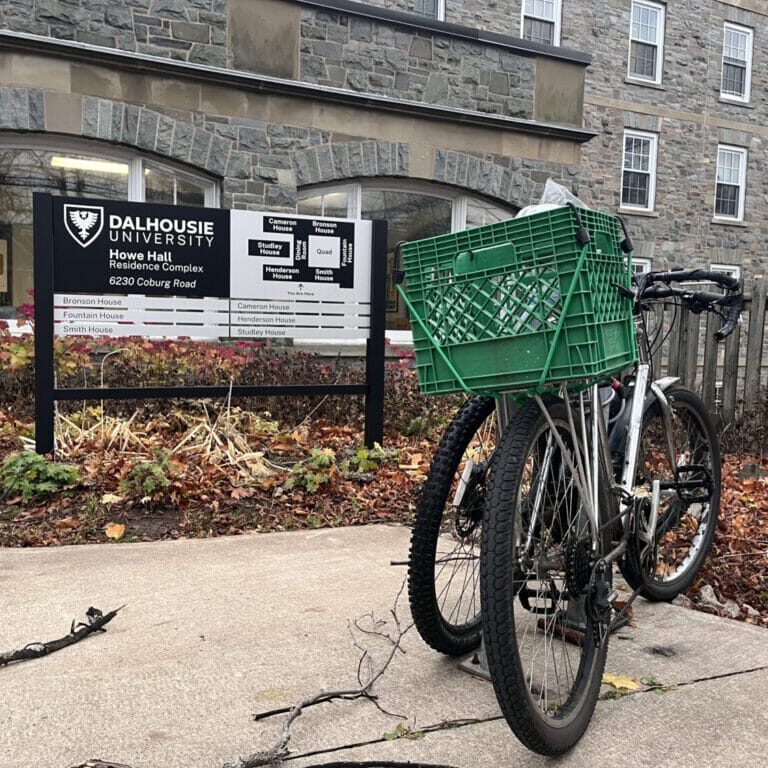
The accessibility of sustainable transportation in Halifax
Experts weigh in on Halifax’s problem with sustainable transportation
For Cara Cripton-Inglis and Andrew Ollerhead, layers of clothing are protection against the November wind and bike helmets are protection against the too often unsafe streets of Halifax.
They are both members of the Bike Centre and Society at Dalhousie University and advocate for better biking infrastructure around the city.
“Although there is a growing number of routes, there’s very few of them that are connected to one another, so there are bike routes, but there’s no bike network. And that’s the real problem,” Ollerhead said.
Sustainable transportation options include walking, biking and public transit. These methods help to reduce the carbon footprint associated with the transportation sector which accounts for 35% of Nova Scotia’s greenhouse gas emissions and is the second-highest source of emissions.
Although these sustainable options are available throughout Halifax, there are still barriers to accessing them. One of those barriers is safety.
Ollerhead said, “I’ve biked regularly for probably a year and a half now and the number of very close calls that I’ve had is probably at least five or six … and that’s kind of the reality of the situation right now, you have stretches of refuge where there are bike lanes, and then you’re kind of on your own for the next couple 100 meters.”
The Bike Society organizes events for students to try and improve biking safety. These include informational events, workshops to improve reflective gear and group biking trips.
Cripton-Inglis, one of the Bike Society presidents, said, “We do what we can to make people feel safer. This is part of the idea with the trips that we lead … a lot of people will come, and they say, ‘I just don’t feel comfortable biking alone on the streets.’ And so, the more they bike in a group, the more confident they feel and then they’ll go and do it alone.”
Eighty-one per cent of commuters in Halifax use private vehicles as their main mode of commuting according to the most recent census data. Eight per cent of commuters use public transit as their main mode of commuting and only 1 per cent use bicycles.
Ahsan Habib is a professor in the planning and engineering departments at Dalhousie University. He specializes in transportation research and is also the director of the Dalhousie Transportation Collaboratory (DalTRAC).
“I think we are still a car-oriented society,” Habib said. “Halifax is a happening city now, it’s a growing city; we are probably the fastest growing municipality in Canada right now. But we are not acting like one.”
In 2017, Halifax adopted the Integrated Mobility Plan (IMP) to improve sustainable transportation for residents. The plan outlines goals of building complete streets and networks to encourage walking and biking, prioritizing and enhancing transit service and increasing transportation safety.
While the plan addresses issues surrounding transportation, many action items have been delayed.
Habib said, “I think there is a lack of vision for us. Our IMP was adopted prior to the population spike. So, we haven’t come up with a strategic plan, how we will improvise our system sustainably to accommodate the growth.”
Ben Hammer is a transportation officer for the Ecology Action Centre. He sees the IMP as a guide rather than an actionable plan.
Hammer said, “The IMP is not a transportation master plan. The IMP puts forth 136 solid project ideas worth further exploration … but it’s not as specific as the transportation master plans other municipalities in Canada of similar size will have, that specifically itemize infrastructure projects and timelines for them.”
One of the barriers to improved transit is the lack of bus drivers.
Hammer said, “There is demand for transit but recruiting and retaining enough of a staff of drivers to deliver on the demand for transit has been the issue.”
According to Hammer, ridership for Halifax transit has grown significantly and overcrowding on existing bus routes has become a problem. But, without more bus drivers, there are limits to how the transit network can be expanded.
“I have been meeting with the transit operator’s union to get a sense of labour conditions for bus drivers. And one of the issues that has come repeatedly is access to washrooms,” Hammer said. “Who is going to sign up for a job that isn’t able to provide predictable washroom access for four to eight hours or even longer.”
Without sufficient resources like bus drivers the transit system cannot expand, and without expansion there is no reliable alternative to cars.
Ollerhead said, “It is unfortunate that people feel that there’s no acceptable alternative to driving. The people are mad about the [reduced] parking spots, but the reason is that they don’t feel there’s any other option than driving.”
However, progress has been made throughout Halifax. The last few years have seen an increase in bike lanes, a more complete transit network and safer crosswalks.
Argyle Street serves as an example of a successful shared road where cars are not prioritized. The wide sidewalks on the vibrant downtown street bustle with pedestrians and cyclists whose safety isn’t jeopardized.
“Halifax is in a very promising position since it’s a university town. There are lots of students from out of province and students who do not own cars,” said Habib. “So, we have an opportunity. We just need the right infrastructure in the right place.”






